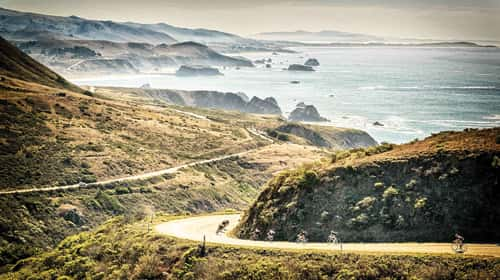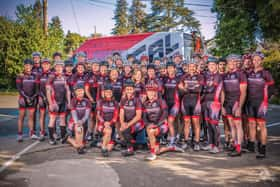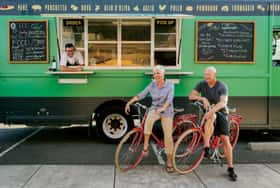 The North Bay is a mecca in the cycling world. And while locations such as Dry Creek Valley, Los Carneros, and Alexander Valley evoke certain images in the minds of wine connoisseurs the world over, places like King Ridge, Coleman Valley Road and “The Geysers” stir up images in the minds of cyclists around the globe.
The North Bay is a mecca in the cycling world. And while locations such as Dry Creek Valley, Los Carneros, and Alexander Valley evoke certain images in the minds of wine connoisseurs the world over, places like King Ridge, Coleman Valley Road and “The Geysers” stir up images in the minds of cyclists around the globe.
Whether a cyclist is visiting from out of state and signs up for Levi’s annual Gran Fondo, a San Franciscan who is looking for an escape from an urban landscape,  or a local just out for their usual weekend group ride, the names of these climbs, and others on our North Bay back roads, have become famous throughout the world for their topography, their beauty, and their challenge.
or a local just out for their usual weekend group ride, the names of these climbs, and others on our North Bay back roads, have become famous throughout the world for their topography, their beauty, and their challenge.
“With our climate, cycling is almost a full year-round activity here,” says Tina Luster, communications manager for Sonoma County Tourism who has seen an increase in tourists coming to bike in the region. “Almost any day you can go out cycling. We also offer a diversity of landscape. We have some nice straight and flat roads that are attractive to beginners and those who don’t want to put a lot of effort into it. But you also have King Ridge, Cavedale Road, and a number of extremely challenging routes that appeal to people getting ready for a race or that just want that professional route experience,” she says. “There aren’t a lot of destinations that offer as much diversity of landscape. Cyclists can choose to ride by lush vineyards, the meadows and valleys, or get off road a bit and ride through the redwoods or along the coastline.”
A cycling mecca
Businesses that cater to the cycling community have seen an uptick in cycling in the area over the past decade, especially as California hit the world cycling stage in 2006 with the Amgen Tour of California. A Tour de France-style road race, Amgen covers hundreds of miles over eight days throughout California with professional cycling teams that have included Olympic medalists, Tour de France contenders and world champions. The tour is now an annual event in the spring and has passed through, or had a stage finish, in the North Bay several times.
“Levi Leipheimer, being a local now, helped promote cycling in the area,” says John Prouty, member of the board of directors for the Red Peloton, a Santa Rosa-based amateur cycling team and club and nonprofit organization that promotes all aspects of cycling. (Leipheimer is a former professional road-racing cyclist who was a U.S. national champion, an Olympic medalist, and winner of three editions of the Tour of California.) “It’s cool when you have someone in your backyard who is on the world stage and competing there with the best in the world.”
Prouty also acts as a captain and program manager for the GranFondo marshal program and organizes a fleet of 165 volunteers, many of them Red Peloton members, who help marshal the course of Levi Leipheimer’s King Ridge GranFondo event held every fall, since 2009. Levi’s GranFondo is a large scale bicycle ride that has drawn up to 7,500 professional and amateur cyclists. Its on the bucket list of many cyclists from around the world and has hosted participants from all 50 states and from six continents. This year the GranFondo expects to have approximately 5,000 participants. The volunteer marshals act as ambassadors for the county and play a pivotal role in keeping the riders safe, especially out-of-towners who are not familiar with the terrain and hazards on the west county roads.
“A lot of things that we’ve tried to do is promote cycling in Sonoma County,” says Prouty of the Red Peloton team’s involvement in the GranFondo and other cycling events throughout the county. “Every single one of us is a huge proponent of cycling in Sonoma County. When there are opportunities to help promote cycling through charitable events we want to make sure that people who come in from out of town have an enjoyable time and want to come back. One of the ways that we can contribute is through some of the work that we do in terms of marshaling.”
The Millennial effect
As in many other industries, Millennials are changing the face of tourism. While wine tasting and fine dining traditionally attracted visitors to the area, Millennials are looking for adventure. They want to stay active while they’re on vacation and often add cycling to the mix of activities. 
“Visitors to Napa are looking for something more than just ‘I’m going to go to a tasting room and taste wine all day’,” says Linzi Gay, general manager of the Clif Family Winery and Farm that offers cycling adventures. “We have seen in some of the data that the average number of tasting room visits has gone down per day. It used to be that people would hit six wineries a day and taste all day, but now it’s more experience driven. I think a lot of that has to do with the Millennials. They’re looking for more experiences and ‘Instagramable moments’. I find for our business, to be competitive as a tasting room these days, you have to have a solid experience and be authentic at what you do. For us, that’s been through cycling.” (See “Clif Family Winery Combines Wheels & Wine” on page XX.)
The increase in “active tourism” is what prompted Phil Fifer, owner of Sonoma Bike Guides of Santa Rosa to sell his bike shop, Breakaway Bikes in Rohnert Park, three years ago.
“I could see tourism go up by the amount of phone calls I was getting with questions like: ‘Where can I rent a bike?’ or ‘Does anyone do bike tours in this area?’,” says Fifer. “Tourism was definitely growing in this area, so I saw that as a better opportunity. I was transitioning as the industry was transitioning. More and more people were looking to get some sort of fitness while they’re on vacation, and this allows them to be out on vacation and get some exercise, and get out and see the area.”
In response to market demand, Fifer offers everything from bike rentals to route and trip planning both locally and out of state. He caters to both tourists coming into the area and local Bay Area cyclists looking to go out of town and needing help with trip planning, luggage and gear transportation, or race support. He provides skills clinics to help cyclists with learning rules of the road, bike maintenance and repair, and specific bike handling skills. Bike Monkey, a Santa Rosa-based events management firm that produces, manages, and supports cycling and running events, often hires him to help manage events, provide SAG vehicles, man aid stations and do course marking. In his business, which is year round given the mild climate, Fifer estimates that about 60 percent of customers are “true tourists,” coming from other states or countries. The other 40 percent are locals or from around the Bay Area, who come to the county for a day trip.
Fifer attributes the rise in cycling overall to an increased awareness on fitness and health. Many runners have transitioned to cycling, sometimes on the advice of their doctor, for the lower impact it has on their body. Cycling tends to cause less injuries than running and other repetitive motion sports.
Beyond the road
The relatively new sport of mountain biking has also contributed to the overall growth in the cycling industry.
“Mountain biking has brought the industry way up as a whole because there are people that never thought they would want to road ride,” says Fifer. “But mountain biking is a fairly new sport in the big picture. It’s really only about 30 years old. It’s drawing a new, younger generation. But what people are realizing is that they like cycling so much it’s getting them into road biking. The growth of mountain biking has helped cycling in general.”
The popularity of mountain biking in Sonoma County prompted Glenn Fant, owner of Norcal Bike Sport and Bike Peddler in Santa Rosa, to open a third location, Trail House, to appeal to this sector. Trail House is a bike-friendly ale house and café where visitors can get an espresso and house granola to help fuel their ride in the morning, and a local micro-brew and sandwich post ride. Cyclists can also demo, rent and purchase bikes at the shop.
“I was seeing the popularity of craft brew in Sonoma County, in particular Russian River Brewing Company,” says Fant. “I would see lines of cars outside with bikes on the back—people coming up from all over the Bay Area to ride Annadel and then they’d go to Russian River to drink beer. Those people come down Highway 12 and would never see Norcal or the Bike Peddler [located on College Ave]. We wanted to combine a bike shop with beer and capture some of that business.”
Fant estimates that about 50 percent of Trail House’s business comes from out-of-towners, with most tourists coming on the weekends. Ironically, the new place doesn’t attract only cyclists, but many others who just enjoy the atmosphere and use it as a fun meeting place.
“The bike business has changed in the last 10 years,” says Fant. “Retail, and how people shop has changed. You need to provide more—people want an experience. Most of what we sell you can get on Amazon or elsewhere on the Internet so we need to provide something more. [The Trail House] is a gathering spot for the cycling community and a cool place for tourists and cyclists to hang out.”
Alternative transportation
Many city leaders and county government officials welcome the rise in cycling, not just because of the tourism revenue, but also because it helps relieve transportation burdens for our growing population. The more people use bikes to commute and traverse around town, the less cars there are on the road and the less parking and congestion issues cities will have. According to the U.S. Census Bureau, the number of people who commute to work by bicycle increased over 60 percent since 2000. From 2008 to 2012, about 786,000 Americans commuted by bicycle, up from about 488,000 in 2000. That is the largest percentage increase of all commuting categories tracked by the 2000 Census and the 2008-2012 American Community Survey.
To that end, local governments, citizens and other organizations have been working on infrastructure improvements to make cycling a safe and accessible alternative to cars.
“For decades, our infrastructure was primarily focused on motor vehicles, and hasn’t supported biking on a regular basis,” says Patrick Band, executive director of the Napa County Bicycle Coalition. “You’re now seeing things like Caltrans for the first time ever setting hard goals of tripling bicycling and doubling walking in the state. That’s Caltrans which is not normally thought of as a particularly bike friendly agency. You have local cities and towns beginning to include bicycling or pedestrian accessibility on a regular basis when they’re building new streets or repaving roadways. Communities are installing green lanes and protected bike lanes, and supporting businesses that want to install bike racks. Riding a bike is becoming a much more acceptable and easy-to- choose option for everyday commuting.”
Most Bay Area counties have bicycle coalitions that advocate for, and educate the public about, cycling in their communities. The Napa County Bicycle Coalition, a 501(3)c nonprofit, is an advocacy organization which aims to making riding a bike in Napa County safe, convenient and accessible for all riders. Their outreach and education programs include teaching bike safety to low-income youth, raising awareness of riding bikes for recreation and transportation, and hosting various community events such as Napa BikeFest, Carneros Family Ride and Kidical Mass. Through their grassroots advocacy and policy programs, the coalition aims to make local communities more bike friendly and expand bike infrastructure.
“There are dozens of organized bike rides that happen in Napa County throughout the year, from weekly club rides to larger events that bring 3,000 to 4,000 people to the valley for a 100-mile bike ride,” says Band.
“Although we don’t put those kinds of rides on, we’re supportive of those activities because they get more folks out riding bikes, which is a good thing. They also provide valuable benefits to our community through tax revenue and tourism, bringing folks to the valley to ride bikes as tourists,” he continues. “Data from the Visit Napa Valley economic impact report shows that people who do bike tourism, compared to traditional tourists, spend more money and stay longer in the areas that they’re visiting.”
Sidebar 1: Clif Family Winery Combines Wheels and Wine
Starting the day with a strong espresso and a Clif Bar, visitors to Clif Family Winery in Saint Helena are treated to a quintessential wine country day, regardless if they are avid cyclists or not. Whether someone is aiming for a KOM up Howell Mountain Road on the latest high performance, all-carbon bike, or simply taking a leisurely eight-mile loop around Saint Helena on a cruiser, guests will leave feeling welcomed and satiated.
Gary Erickson and Kit Crawford, owners of Clif Bar & Company, which Erickson founded in 1992, moved to Napa about 20 years ago. They started making wine on a small scale about ten years ago and it wasn’t long before they envisioned the idea of adding cycling adventures to their winery, inspired by many cycling trips in Italy. The couple often rode around the Dolomite region in Northern Italy and stopped at “rifugi”—alpine huts that offer beer, wine, good food and hospitality. Erickson and Crawford wanted to build a place reminiscent of their experiences in Italy. To that end, they endeavored to make their Clif Family tasting room into a destination for both local cyclists and tourists, offering espressos and Clif bars in the morning, and wine and lunch provided from their organic farm and vineyards atop Howell Mountain, post ride.
“When we started six years ago, the [general] mentality was: Wineries didn’t want cyclists in their tasting rooms. Their shoes scuff up their floors, and they can’t take wine with them so they’re not buying wine,” explains Linzi Gay, general manager of the Clif Family Winery and Farm. “We’re proud to say that has changed a lot because people realized that it costs a lot to get started in cycling. It’s a sport that has synergy with what we offer in the Napa Valley and what a cyclist is going to appreciate, whether that’s beer, wine or food. In the last few years, we also found there is much more around bringing together food, wine, cycling—all those aspects.”
The Clif Family Winery partnered with Calistoga Bike Shop to offer bicycle rental packages that fit any level, from the “Tour de St. Helena”—an eight-mile loop on a cruiser bike to “The White Road”—routes from 20 to 60 miles long through the Napa Valley hills on high performance road bikes. Both self-guided packages are followed by Clif Family wine tasting and signature food pairings, or lunch from the Clif Family Bruschetteria Food Truck, which takes a “farm to truck” approach to cooking using only the freshest and most local ingredients possible.
“We get a lot of people who are day-trippers from the Bay Area who want to do something different and more active up here,” says Gay. “So they’ll come and start in the morning and do a ride before they wine taste for the day. We see quite a few younger people coming in and doing that—groups of six to eight people sometimes who all want to rent bikes and it’s more of a social thing. I think the demographics have shifted a little bit to more Millennials who are coming and looking for something beyond just wine tasting.”
Gay also credits the Napa Valley Vine Trail for encouraging more people to get out and ride bikes because they can now do so safely. For those cyclists who did not want to climb, there were few opportunities to do so on non-heavily trafficked roads. On busy weekends, the main thoroughfares through town did not make ideal conditions for cycling.
“I see people on that trail all the time,” says Gay. “All summer it’s gotten busier and busier. There’s this culture of cycling that the Vine Trail has been able to bring. What it brought is more recreational cycling—people who are just coming on their bikes to see the beautiful Napa Valley rather than to do a 50-mile ride. They’re very different.”
The Clif Family Winery instituted “Club Peloton,” the only wine- cycling club in the world that Gay is aware of. Besides discounts on wines and Clif bar products, members receive complimentary tastings, shipments of wine, and some of the newest Clif products (often before they hit the market) as well as invitations to events such as the annual ride and lunch with owners Gary and Kit in September. The club currently stands at about 150 members, who can also purchase a Club Peloton cycling kit.
“We try to do things to bring the cycling community together,” says Gay. “We have a lot of Bay Area residents so we did an event in Emeryville where they could tour Clif Bar, and do a ride and have dinner together. We bring cycling into a lot of aspects of our business.”




